Marine Boundary Layer Cloud Boundaries and Phase Estimation Using Airborne Radar and In Situ Measurements During the SOCRATES Campaign over Southern Ocean
Abstract
1. Introduction
- (1)
- Develop a method to identify cloud bases and top heights using HCR measurements, providing cloud boundary estimation without radiosonde or dropsonde data. We further derive an LWC-Z exponential relationship from in situ measured liquid water content (LWC) and calculated reflectivity (Z) from CDP and 2D-S probes and apply it to HCR reflectivity profiles to obtain radar-based LWC and liquid water paths (LWPs).
- (2)
- Present a cloud-phase estimation method for low-level clouds sampled during SOCRATES using a combination of HCR measurements, temperature profiles, and estimated LWPs, and compare the resulting phase retrievals with existing products over the SO. This simplistic approach integrates radar and in situ observations under physical microphysical constraints, addressing the limitations of probe-only classifications, remains effective where lidar retrievals are unavailable or compromised by strong signal attenuation, and offers improved physical consistency compared to empirically weighted classification methods.
2. Materials and Methods
2.1. SOCRATES In Situ and Remote Sensing Datasets
2.2. Estimating LWC-Z Relationship and LWP from In Situ Measurements
2.3. Classifying Low-Level Clouds over SO
2.3.1. Identifying Cloud Boundaries Using HCR Measurements
2.3.2. Determination of Cloud Phase
3. Results and Discussions
3.1. Cloud Boundaries, LWC, and LWP: Results, Discussion, and Evaluation
3.1.1. HCR-Derived Cloud-Base and Top Heights (Hbase and Htop)
3.1.2. Cloud LWC and LWP
3.2. Results from Low-Level Cloud Phase Classification
3.3. Evaluation of Phase-Classification Results with Existing Methods
3.3.1. Comparison with In Situ Phase Classification (MLR)
3.3.2. Comparisons with Fuzzy Logic Particle Identification (PID)
3.3.3. Comparison with Ship-Based Phase Classification During MARCUS
3.4. Bulk Statistical Comparisons Between HCR Phase and the Other Methods
3.5. Evaluation of HCR Phase with HSRL-Based Phase Detections
3.6. Sensitivity Analysis of Cloud-Boundary and Phase Classification
4. Summary and Conclusions
- HCR-derived cloud base heights (Hbase) show good agreement with HSRL-derived Hbase for both drizzling and non-drizzling cloud cases under zenith-pointed conditions, with mean differences around 0.25 km and 0.21 km, respectively. For nadir-pointing cases, strong attenuation in HSRL signals prevented a reliable Hbase estimation by lidar; however, HCR continued to provide consistent cloud-base detection. Cloud boundaries derived from in situ measurements for 29 cases coinciding with valid HCR profiles showed mean Htop and Hbase differences of less than 100 m. Furthermore, the HCR-derived Htop and Hbase during SOCRATES and the ship-based MARCUS (MPL/ceilometer/WACR) campaign over a collocated region showed close agreement, with mean differences of 0.03 km for Hbase and 0.3 km for Htop for both drizzling and non-drizzling cases.
- In situ measured LWC and the calculated reflectivity (Z) from CDP and 2D-S in situ measurements were used to derive an empirical exponential relationship: LWC = 0.70Z0.29, which was applied to HCR-reflectivity data to retrieve LWC profiles. Using these LWC profiles and cloud thickness, LWP was estimated for each cloud category with an associated uncertainty of approximately ±20 g/m2. The mean LWP was ~135.6 g/m2 during SOCRATES, which is in close agreement with MWR-retrieved LWP during the MARCUS campaign, showing a mean difference of 11.7 g/m2.
- The phase-classification method (HCR phase) categorized cloud profiles into liquid, mixed, and ice phases, with occurrence frequencies of 40.6%, 18.3%, and 5.1%, respectively. Additional hydrometeor types—drizzle (29.1%), rain (3.2%), and snow (3.7%)—were identified in drizzling cloud cases. The HCR-phase classifications were evaluated against four reference methods: MLR, PID, WACR-MWR, and Thermodynamic-Cloud Phase. Comparison with PID showed a 70% hit rate across overlapping phase samples, while agreement with the in situ MLR phase was 60%, limited by fewer overlapping samples and methodological differences. Furthermore, bulk statistical comparisons with MARCUS-based cloud-phase identification methods showed a strong consistency (>90%) across liquid, mixed, and ice categories. A comparison of HCR, HSRL, and combined radar–lidar phase retrievals showed that lidar contributed less than ~1% of additional detections, confirming that the radar-only method provides robust and reliable phase classification for MBL clouds over the SO.
- Sensitivity analyses show that cloud-boundary and phase classifications are most affected by reflectivity perturbations, with smaller impacts from Doppler velocity, spectrum width, and LWP threshold changes. Overall, the methods remain robust—Hbase varies mainly in drizzling clouds, while phase fractions shift modestly, indicating a stable classification performance within typical HCR and retrieval uncertainties.
Supplementary Materials
Author Contributions
Funding
Data Availability Statement
Acknowledgments
Conflicts of Interest
Abbreviations
| SOCRATES | Southern Ocean Clouds, Radiation, Aerosol Transport Experimental Study |
| SO | Southern Ocean |
| MBL | Marine Boundary Layer |
| HCR | HIAPER Cloud Radar |
| HSRL | High Spectral Resolution Lidar |
| MPL | Micropulse Lidar |
| MARCUS | Measurement of Aerosols, Radiation, and Clouds |
| LWC | Liquid Water Content |
| LWP | Liquid Water Path |
| SLW | Supercooled Liquid Water |
| CDP | Cloud Droplet Probe |
| 2D-S | Two-Dimensional, Stereo, Particle Imaging Probe |
| GV | Gulfstream-V |
| PSD | Particle Size Distributions |
| DSD | Droplet Size Distribution |
| PLDR | Particle Depolarization Ratio |
| MWR | Microwave Radiometer |
| Probability Density Function | |
| ERA5 | ECMWF Reanalysis v5 |
| ECMWF | European Centre for Medium-Range Weather Forecasts |
| Z | Radar Reflectivity Factor |
| dBZ | Radar Reflectivity Factor in Decibels (dB) |
| WID | Spectrum Width |
| Vd | Doppler Velocity |
| MLR | Multinomial Logistic Regression |
| PID | Particle Identification Scheme |
| ARM | Atmospheric Radiation Measurement |
| ENA | Eastern North Atlantic (ENA) |
| WACR | W-band ARM Cloud Radar |
Appendix A
Appendix A.1. Southern Ocean Clouds, Radiation, Aerosol, Transport Experimental Study (SOCRATES) Aircraft Field-Campaign
| Instrument | Measurements and Uncertainty | Size Range/ Resolution | References |
|---|---|---|---|
| Cloud Droplet Probe (CDP) | Size distribution and concentration of hydrometeors with a diameter between 2 and 50 µm
| 2–50 µm | [46,47] |
| Two-Dimensional, Stereo, Particle Imaging Probe (2D-S) | Size distribution and concentration of hydrometeors with a diameter between 10 and 1280 µm range
|
| [48,49,84] |
| HIAPER Cloud Radar (HCR) | Reflectivity, Doppler velocity, spectral width, Linear Depolarization Ratio (LDR), etc.
| ~19 m in vertical resolution Frequency: 94.40 GHz | [50,51,52] |
| High Spectral Resolution Lidar (HSRL) | Backscatter coefficient, Particle Linear Depolarization Ratio (PLDR), Extinction Coefficient, etc.
| Wavelength: 532 nm | [53,54,55] |
Appendix A.2. Measurements from the Measurement of Aerosols, Radiation, and Clouds over the Southern Ocean (MARCUS) Ship-Based Field Campaign and Spatial Matching with SOCRATES

References
- Trenberth, K.E.; Fasullo, J.T. Simulation of Present-Day and Twenty-First-Century Energy Budgets of the Southern Oceans. J. Clim. 2010, 23, 440–454. [Google Scholar] [CrossRef]
- McCoy, D.T.; Hartmann, D.L.; Grosvenor, D.P. Observed Southern Ocean Cloud Properties and Shortwave Reflection. Part II: Phase Changes and Low Cloud Feedback. J. Clim. 2014, 27, 8858–8868. [Google Scholar] [CrossRef]
- Bodas-Salcedo, A.; Hill, P.G.; Furtado, K.; Williams, K.D.; Field, P.R.; Manners, J.C.; Hyder, P.; Kato, S. Large Contribution of Supercooled Liquid Clouds to the Solar Radiation Budget of the Southern Ocean. J. Clim. 2016, 29, 4213–4228. [Google Scholar] [CrossRef]
- Kay, J.E.; Wall, C.; Yettella, V.; Medeiros, B.; Hannay, C.; Caldwell, P.; Bitz, C. Global Climate Impacts of Fixing the Southern Ocean Shortwave Radiation Bias in the Community Earth System Model (CESM). J. Clim. 2016, 29, 4617–4636. [Google Scholar] [CrossRef]
- Wang, Y.; Zhang, D.; Liu, X.; Wang, Z. Distinct Contributions of Ice Nucleation, Large-Scale Environment, and Shallow Cumulus Detrainment to Cloud Phase Partitioning with NCAR CAM5. J. Geophys. Res. Atmos. 2018, 123, 1132–1154. [Google Scholar] [CrossRef]
- D’Alessandro, J.J.; McFarquhar, G.M.; Wu, W.; Stith, J.L.; Jensen, J.B.; Rauber, R.M. Characterizing the Occurrence and Spatial Heterogeneity of Liquid, Ice, and Mixed Phase Low-Level Clouds Over the Southern Ocean Using in Situ Observations Acquired During SOCRATES. J. Geophys. Res. Atmos. 2021, 126, e2020JD034482. [Google Scholar] [CrossRef]
- Jiang, J.H.; Su, H.; Wu, L.; Zhai, C.; Schiro, K.A. Improvements in Cloud and Water Vapor Simulations Over the Tropical Oceans in CMIP6 Compared to CMIP5. Earth Space Sci. 2021, 8, e2020EA001520. [Google Scholar] [CrossRef]
- Li, J.-L.F.; Xu, K.-M.; Jiang, J.H.; Lee, W.-L.; Wang, L.-C.; Yu, J.-Y.; Stephens, G.; Fetzer, E.; Wang, Y.-H. An Overview of CMIP5 and CMIP6 Simulated Cloud Ice, Radiation Fields, Surface Wind Stress, Sea Surface Temperatures, and Precipitation Over Tropical and Subtropical Oceans. J. Geophys. Res. Atmos. 2020, 125, e2020JD032848. [Google Scholar] [CrossRef]
- Vignesh, P.P.; Jiang, J.H.; Kishore, P.; Su, H.; Smay, T.; Brighton, N.; Velicogna, I. Assessment of CMIP6 Cloud Fraction and Comparison with Satellite Observations. Earth Space Sci. 2020, 7, e2019EA000975. [Google Scholar] [CrossRef]
- Zelinka, M.D.; Myers, T.A.; McCoy, D.T.; Po-Chedley, S.; Caldwell, P.M.; Ceppi, P.; Klein, S.A.; Taylor, K.E. Causes of Higher Climate Sensitivity in CMIP6 Models. Geophys. Res. Lett. 2020, 47, e2019GL085782. [Google Scholar] [CrossRef]
- Zheng, X.; Tao, C.; Zhang, C.; Xie, S.; Zhang, Y.; Xi, B.; Dong, X. Assessment of CMIP5 and CMIP6 AMIP Simulated Clouds and Surface Shortwave Radiation Using ARM Observations over Different Climate Regions. J. Clim. 2023, 36, 8475–8495. [Google Scholar] [CrossRef]
- Chen, G.; Wang, W.-C.; Bao, Q.; Li, J. Evaluation of Simulated Cloud Diurnal Variation in CMIP6 Climate Models. J. Geophys. Res. Atmos. 2022, 127, e2021JD036422. [Google Scholar] [CrossRef]
- McCoy, I.L.; McCoy, D.T.; Wood, R.; Regayre, L.; Watson-Parris, D.; Grosvenor, D.P.; Mulcahy, J.P.; Hu, Y.; Bender, F.A.-M.; Field, P.R.; et al. The Hemispheric Contrast in Cloud Microphysical Properties Constrains Aerosol Forcing. Proc. Natl. Acad. Sci. USA 2020, 117, 18998–19006. [Google Scholar] [CrossRef] [PubMed]
- McCoy, I.L.; Bretherton, C.S.; Wood, R.; Twohy, C.H.; Gettelman, A.; Bardeen, C.G.; Toohey, D.W. Influences of Recent Particle Formation on Southern Ocean Aerosol Variability and Low Cloud Properties. J. Geophys. Res. Atmos. 2021, 126, e2020JD033529. [Google Scholar] [CrossRef]
- Wild, M. The Global Energy Balance as Represented in CMIP6 Climate Models. Clim. Dyn. 2020, 55, 553–577. [Google Scholar] [CrossRef] [PubMed]
- Stephens, G.L.; L’Ecuyer, T.; Forbes, R.; Gettelmen, A.; Golaz, J.-C.; Bodas-Salcedo, A.; Suzuki, K.; Gabriel, P.; Haynes, J. Dreary State of Precipitation in Global Models. J. Geophys. Res. Atmos. 2010, 115, D24211. [Google Scholar] [CrossRef]
- Donner, L.J.; Wyman, B.L.; Hemler, R.S.; Horowitz, L.W.; Ming, Y.; Zhao, M.; Golaz, J.-C.; Ginoux, P.; Lin, S.-J.; Schwarzkopf, M.D.; et al. The Dynamical Core, Physical Parameterizations, and Basic Simulation Characteristics of the Atmospheric Component AM3 of the GFDL Global Coupled Model CM3. J. Clim. 2011, 24, 3484–3519. [Google Scholar] [CrossRef]
- Hu, Y.; Rodier, S.; Xu, K.; Sun, W.; Huang, J.; Lin, B.; Zhai, P.; Josset, D. Occurrence, Liquid Water Content, and Fraction of Supercooled Water Clouds from Combined CALIOP/IIR/MODIS Measurements. J. Geophys. Res. Atmos. 2010, 115, D00H34. [Google Scholar] [CrossRef]
- Dong, X.; Xi, B.; Kennedy, A.; Minnis, P.; Wood, R. A 19-Month Record of Marine Aerosol–Cloud–Radiation Properties Derived from DOE ARM Mobile Facility Deployment at the Azores. Part I: Cloud Fraction and Single-Layered MBL Cloud Properties. J. Clim. 2014, 27, 3665–3682. [Google Scholar] [CrossRef]
- Wu, P.; Dong, X.; Xi, B.; Tian, J.; Ward, D.M. Profiles of MBL Cloud and Drizzle Microphysical Properties Retrieved From Ground-Based Observations and Validated by Aircraft In Situ Measurements Over the Azores. J. Geophys. Res. Atmos. 2020, 125, e2019JD032205. [Google Scholar] [CrossRef]
- Zhao, L.; Zhao, C.; Wang, Y.; Wang, Y.; Yang, Y. Evaluation of Cloud Microphysical Properties Derived From MODIS and Himawari-8 Using In Situ Aircraft Measurements Over the Southern Ocean. Earth Space Sci. 2020, 7, e2020EA001137. [Google Scholar] [CrossRef]
- Jackson, R.C.; McFarquhar, G.M.; Korolev, A.V.; Earle, M.E.; Liu, P.S.K.; Lawson, R.P.; Brooks, S.; Wolde, M.; Laskin, A.; Freer, M. The Dependence of Ice Microphysics on Aerosol Concentration in Arctic Mixed-Phase Stratus Clouds during ISDAC and M-PACE. J. Geophys. Res. Atmos. 2012, 117, D15207. [Google Scholar] [CrossRef]
- Qiu, S.; Dong, X.; Xi, B.; Li, J.-L.F. Characterizing Arctic Mixed-Phase Cloud Structure and Its Relationship with Humidity and Temperature Inversion Using ARM NSA Observations. J. Geophys. Res. Atmos. 2015, 120, 7737–7746. [Google Scholar] [CrossRef]
- Moser, M.; Voigt, C.; Jurkat-Witschas, T.; Hahn, V.; Mioche, G.; Jourdan, O.; Dupuy, R.; Gourbeyre, C.; Schwarzenboeck, A.; Lucke, J.; et al. Microphysical and Thermodynamic Phase Analyses of Arctic Low-Level Clouds Measured above the Sea Ice and the Open Ocean in Spring and Summer. Atmos. Chem. Phys. 2023, 23, 7257–7280. [Google Scholar] [CrossRef]
- Heymsfield, A.J.; Schmitt, C.; Chen, C.; Bansemer, A.; Gettelman, A.; Field, P.R.; Liu, C. Contributions of the Liquid and Ice Phases to Global Surface Precipitation: Observations and Global Climate Modeling. J. Atmos. Sci. 2020, 77, 2629–2648. [Google Scholar] [CrossRef]
- Zhao, X.; Liu, X.; Burrows, S.; DeMott, P.J.; Diao, M.; McFarquhar, G.M.; Patade, S.; Phillips, V.; Roberts, G.C.; Sanchez, K.J.; et al. Important Ice Processes Are Missed by the Community Earth System Model in Southern Ocean Mixed-Phase Clouds: Bridging SOCRATES Observations to Model Developments. J. Geophys. Res. Atmos. 2023, 128, e2022JD037513. [Google Scholar] [CrossRef]
- Liu, Y.G.; Yau, M.-K.; Shima, S.-I.; Lu, C.S.; Chen, S.S. Parameterization and Explicit Modeling of Cloud Microphysics: Approaches, Challenges, and Future Directions. Adv. Atmos. Sci. 2023, 40, 747–790. [Google Scholar] [CrossRef]
- Shupe, M.D. A Ground-Based Multisensor Cloud Phase Classifier. Geophys. Res. Lett. 2007, 34, L22809. [Google Scholar] [CrossRef]
- D’Alessandro, J.J.; Diao, M.; Wu, C.; Liu, X.; Jensen, J.B.; Stephens, B.B. Cloud Phase and Relative Humidity Distributions over the Southern Ocean in Austral Summer Based on In Situ Observations and CAM5 Simulations. J. Clim. 2019, 32, 2781–2805. [Google Scholar] [CrossRef]
- Zaremba, T.J.; Rauber, R.M.; McFarquhar, G.M.; Hayman, M.; Finlon, J.A.; Stechman, D.M. Phase Characterization of Cold Sector Southern Ocean Cloud Tops: Results From SOCRATES. J. Geophys. Res. Atmos. 2020, 125, e2020JD033673. [Google Scholar] [CrossRef]
- Atlas, R.; Mohrmann, J.; Finlon, J.; Lu, J.; Hsiao, I.; Wood, R.; Diao, M. The University of Washington Ice–Liquid Discriminator (UWILD) Improves Single-Particle Phase Classifications of Hydrometeors within Southern Ocean Clouds Using Machine Learning. Atmos. Meas. Tech. 2021, 14, 7079–7101. [Google Scholar] [CrossRef]
- Xi, B.; Dong, X.; Zheng, X.; Wu, P. Cloud Phase and Macrophysical Properties over the Southern Ocean during the MARCUS Field Campaign. Atmos. Meas. Tech. 2022, 15, 3761–3777. [Google Scholar] [CrossRef]
- Schima, J.; McFarquhar, G.; Romatschke, U.; Vivekanandan, J.; D’Alessandro, J.; Haggerty, J.; Wolff, C.; Schaefer, E.; Järvinen, E.; Schnaiter, M. Characterization of Southern Ocean Boundary Layer Clouds Using Airborne Radar, Lidar, and In Situ Cloud Data: Results From SOCRATES. J. Geophys. Res. Atmos. 2022, 127, e2022JD037277. [Google Scholar] [CrossRef]
- Romatschke, U.; Vivekanandan, J. Cloud and Precipitation Particle Identification Using Cloud Radar and Lidar Measurements: Retrieval Technique and Validation. Earth Space Sci. 2022, 9, e2022EA002299. [Google Scholar] [CrossRef]
- Desai, N.; Diao, M.; Shi, Y.; Liu, X.; Silber, I. Ship-Based Observations and Climate Model Simulations of Cloud Phase Over the Southern Ocean. J. Geophys. Res. Atmos. 2023, 128, e2023JD038581. [Google Scholar] [CrossRef]
- Mioche, G.; Jourdan, O.; Ceccaldi, M.; Delanoë, J. Variability of Mixed-Phase Clouds in the Arctic with a Focus on the Svalbard Region: A Study Based on Spaceborne Active Remote Sensing. Atmos. Chem. Phys. 2015, 15, 2445–2461. [Google Scholar] [CrossRef]
- Matus, A.V.; L’Ecuyer, T.S. The Role of Cloud Phase in Earth’s Radiation Budget. J. Geophys. Res. Atmos. 2017, 122, 2559–2578. [Google Scholar] [CrossRef]
- Korolev, A.; Milbrandt, J. How Are Mixed-Phase Clouds Mixed? Geophys. Res. Lett. 2022, 49, e2022GL099578. [Google Scholar] [CrossRef]
- Dong, X.; Das, A.; Xi, B.; Zheng, X.; Behrangi, A.; Marcovecchio, A.R.; Girone, D.J. Quantifying the Differences in Southern Ocean Clouds Observed by Radar and Lidar from Three Platforms. Geophys. Res. Lett. 2025, 52, e2024GL112079. [Google Scholar] [CrossRef]
- Ewald, F.; Groß, S.; Wirth, M.; Delanoë, J.; Fox, S.; Mayer, B. Why We Need Radar, Lidar, and Solar Radiance Observations to Constrain Ice Cloud Microphysics. Atmos. Meas. Tech. 2021, 14, 5029–5047. [Google Scholar] [CrossRef]
- Wang, Z.; French, J.; Vali, G.; Wechsler, P.; Haimov, S.; Rodi, A.; Deng, M.; Leon, D.; Snider, J.; Peng, L.; et al. Single Aircraft Integration of Remote Sensing and In Situ Sampling for the Study of Cloud Microphysics and Dynamics. Bull. Am. Meteorol. Soc. 2012, 93, 653–668. [Google Scholar] [CrossRef]
- Delanoë, J.; Protat, A.; Jourdan, O.; Pelon, J.; Papazzoni, M.; Dupuy, R.; Gayet, J.; Jouan, C. Comparison of Airborne In Situ, Airborne Radar–Lidar, and Spaceborne Radar–Lidar Retrievals of Polar Ice Cloud Properties Sampled during the POLARCAT Campaign. J. Atmos. Ocean. Technol. 2013, 30, 57–73. [Google Scholar] [CrossRef]
- McGill, M.; Hlavka, D.; Hart, W.; Scott, V.S.; Spinhirne, J.; Schmid, B. Cloud Physics Lidar: Instrument Description and Initial Measurement Results. Appl. Opt. 2002, 41, 3725–3734. [Google Scholar] [CrossRef] [PubMed]
- Wang, Z.; Wechsler, P.; Kuestner, W.; French, J.; Rodi, A.; Glover, B.; Burkhart, M.; Lukens, D. Wyoming Cloud Lidar: Instrument Description and Applications. Opt. Express 2009, 17, 13576. [Google Scholar] [CrossRef]
- Sassen, K. The Polarization Lidar Technique for Cloud Research: A Review and Current Assessment. Bull. Am. Meteorol. Soc. 1991, 72, 1848–1866. [Google Scholar] [CrossRef]
- Lance, S.; Brock, C.A.; Rogers, D.; Gordon, J.A. Water Droplet Calibration of the Cloud Droplet Probe (CDP) and in-Flight Performance in Liquid, Ice and Mixed-Phase Clouds during ARCPAC. Atmos. Meas. Tech. 2010, 3, 1683–1706. [Google Scholar] [CrossRef]
- Faber, S.; French, J.R.; Jackson, R. Laboratory and In-Flight Evaluation of Measurement Uncertainties from a Commercial Cloud Droplet Probe (CDP). Atmos. Meas. Tech. 2018, 11, 3645–3659. [Google Scholar] [CrossRef]
- Lawson, R.P.; O’Connor, D.; Zmarzly, P.; Weaver, K.; Baker, B.; Mo, Q.; Jonsson, H. The 2D-S (Stereo) Probe: Design and Preliminary Tests of a New Airborne, High-Speed, High-Resolution Particle Imaging Probe. J. Atmos. Ocean. Technol. 2006, 23, 1462–1477. [Google Scholar] [CrossRef]
- Wu, W.; McFarquhar, G. NSF/NCAR GV HIAPER 2D-S Particle Size Distribution (PSD) Product Data, Version 1.1; NSF NCAR Earth Observing Laboratory: Boulder, CO, USA, 2019. [Google Scholar] [CrossRef]
- NCAR/EOL HCR Team. HIAPER Cloud Radar (HCR); UCAR/NCAR Earth Observing Laboratory: Boulder, CO, USA, 2014. [Google Scholar] [CrossRef]
- Vivekanandan, J.; Ellis, S.; Tsai, P.; Loew, E.; Lee, W.-C.; Emmett, J.; Dixon, M.; Burghart, C.; Rauenbuehler, S. A Wing Pod-Based Millimeter Wavelength Airborne Cloud Radar. Geosci. Instrum. Methods Data Syst. 2015, 4, 161–176. [Google Scholar] [CrossRef]
- Romatschke, U.; Dixon, M.; Tsai, P.; Loew, E.; Vivekanandan, J.; Emmett, J.; Rilling, R. The NCAR Airborne 94-GHz Cloud Radar: Calibration and Data Processing. Data 2021, 6, 66. [Google Scholar] [CrossRef]
- NCAR/EOL HSRL Team. Gulfstream V High Spectral Resolution Lidar (GV-HSRL); UCAR/NCAR Earth Observing Laboratory: Boulder, CO, USA, 2012. [Google Scholar] [CrossRef]
- Eloranta, E.E. High Spectral Resolution Lidar. In Lidar: Range-Resolved Optical Remote Sensing of the Atmosphere; Weitkamp, C., Ed.; Springer: New York, NY, USA, 2005; pp. 143–163. ISBN 978-0-387-25101-1. [Google Scholar]
- Su, W.; Schuster, G.L.; Loeb, N.G.; Rogers, R.R.; Ferrare, R.A.; Hostetler, C.A.; Hair, J.W.; Obland, M.D. Aerosol and Cloud Interaction Observed from High Spectral Resolution Lidar Data. J. Geophys. Res. Atmos. 2008, 113, D24202. [Google Scholar] [CrossRef]
- Zheng, X.; Dong, X.; Xi, B.; Logan, T.; Wang, Y. Distinctive Aerosol–Cloud–Precipitation Interactions in Marine Boundary Layer Clouds from the ACE-ENA and SOCRATES Aircraft Field Campaigns. Atmos. Chem. Phys. 2024, 24, 10323–10347. [Google Scholar] [CrossRef]
- NCAR/EOL HCR Team; NCAR/EOL GV-HSRL Team. SOCRATES: NCAR HCR Radar and GV-HSRL Lidar Moments Data, Version 3.2; NSF NCAR Earth Observing Laboratory: Boulder, CO, USA, 2023. [Google Scholar] [CrossRef]
- Doviak, R.J.; Zrnić, D.S. 8-Precipitation Measurements. In Doppler Radar and Weather Observations, 2nd ed.; Doviak, R.J., Zrnić, D.S., Eds.; Academic Press: San Diego, CA, USA, 1993; pp. 209–279. ISBN 978-0-12-221422-6. [Google Scholar]
- Kang, L.; Marchand, R.; Smith, W. Evaluation of MODIS and Himawari-8 Low Clouds Retrievals Over the Southern Ocean With In Situ Measurements From the SOCRATES Campaign. Earth Space Sci. 2021, 8, e2020EA001397. [Google Scholar] [CrossRef]
- Dong, X.; Mace, G.G. Profiles of Low-Level Stratus Cloud Microphysics Deduced from Ground-Based Measurements. J. Atmos. Ocean. Technol. 2003, 20, 42–53. [Google Scholar] [CrossRef]
- Mioche, G.; Jourdan, O.; Delanoë, J.; Gourbeyre, C.; Febvre, G.; Dupuy, R.; Monier, M.; Szczap, F.; Schwarzenboeck, A.; Gayet, J.-F. Vertical Distribution of Microphysical Properties of Arctic Springtime Low-Level Mixed-Phase Clouds over the Greenland and Norwegian Seas. Atmos. Chem. Phys. 2017, 17, 12845–12869. [Google Scholar] [CrossRef]
- Oh, S.-B.; Lee, Y.H.; Jeong, J.-H.; Kim, Y.-H.; Joo, S. Estimation of the Liquid Water Content and Z–LWC Relationship Using Ka-Band Cloud Radar and a Microwave Radiometer. Meteorol. Appl. 2018, 25, 423–434. [Google Scholar] [CrossRef]
- Vivekanandan, J.; Ghate, V.P.; Jensen, J.B.; Ellis, S.M.; Schwartz, M.C. A Technique for Estimating Liquid Droplet Diameter and Liquid Water Content in Stratocumulus Clouds Using Radar and Lidar Measurements. J. Atmos. Ocean. Technol. 2020, 37, 2145–2161. [Google Scholar] [CrossRef]
- Intrieri, J.M.; Shupe, M.D.; Uttal, T.; McCarty, B.J. An Annual Cycle of Arctic Cloud Characteristics Observed by Radar and Lidar at SHEBA. J. Geophys. Res. Ocean. 2002, 107, SHE 5-1–SHE 5-15. [Google Scholar] [CrossRef]
- Kang, L.; Marchand, R.T.; Wood, R. Stratocumulus Precipitation Properties Over the Southern Ocean Observed From Aircraft During the SOCRATES Campaign. J. Geophys. Res. Atmos. 2024, 129, e2023JD039831. [Google Scholar] [CrossRef]
- Frisch, A.S.; Fairall, C.W.; Snider, J.B. Measurement of Stratus Cloud and Drizzle Parameters in ASTEX with a Kα-Band Doppler Radar and a Microwave Radiometer. J. Atmos. Sci. 1995, 52, 2788–2799. [Google Scholar] [CrossRef]
- Cadeddu, M.P.; Liljegren, J.C.; Turner, D.D. The Atmospheric Radiation Measurement (ARM) Program Network of Microwave Radiometers: Instrumentation, Data, and Retrievals. Atmos. Meas. Tech. 2013, 6, 2359–2372. [Google Scholar] [CrossRef]
- Liljegren, J.C.; Clothiaux, E.E.; Mace, G.G.; Kato, S.; Dong, X. A New Retrieval for Cloud Liquid Water Path Using a Ground-Based Microwave Radiometer and Measurements of Cloud Temperature. J. Geophys. Res. Atmos. 2001, 106, 14485–14500. [Google Scholar] [CrossRef]
- Marcovecchio, A.R.; Xi, B.; Zheng, X.; Wu, P.; Dong, X.; Behrangi, A. What Are the Similarities and Differences in Marine Boundary Layer Cloud and Drizzle Microphysical Properties During the ACE-ENA and MARCUS Field Campaigns? J. Geophys. Res. Atmos. 2023, 128, e2022JD037109. [Google Scholar] [CrossRef]
- Brownscombe, J.L.; Hallett, J. Experimental and Field Studies of Precipitation Particles Formed by the Freezing of Supercooled Water. Q. J. R. Meteorol. Soc. 1967, 93, 455–473. [Google Scholar] [CrossRef]
- McFarquhar, G.M.; Bretherton, C.S.; Marchand, R.; Protat, A.; DeMott, P.J.; Alexander, S.P.; Roberts, G.C.; Twohy, C.H.; Toohey, D.; Siems, S.; et al. Observations of Clouds, Aerosols, Precipitation, and Surface Radiation over the Southern Ocean: An Overview of CAPRICORN, MARCUS, MICRE, and SOCRATES. Bull. Am. Meteorol. Soc. 2021, 102, E894–E928. [Google Scholar] [CrossRef]
- Wang, Z.; Sassen, K. Cloud Type and Macrophysical Property Retrieval Using Multiple Remote Sensors. J. Appl. Meteorol. Climatol. 2001, 40, 1665–1682. [Google Scholar] [CrossRef]
- Flynn, D.; Sivaraman, C.; Comstock, J.; Zhang, D. Micropulse Lidar Cloud Mask (MPLCMASK) Value-Added Product for the Fast-Switching Polarized Micropulse Lidar Technical Report; U.S. Department of Energy, Office of Science, Atmospheric Radiation Measurement (ARM) User Facility: Washington, DC, USA, 2020. [CrossRef]
- Dong, X.; Minnis, P.; Xi, B. A Climatology of Midlatitude Continental Clouds from the ARM SGP Central Facility: Part I: Low-Level Cloud Macrophysical, Microphysical, and Radiative Properties. J. Clim. 2005, 18, 1391–1410. [Google Scholar] [CrossRef]
- Wood, R. Drizzle in Stratiform Boundary Layer Clouds. Part I: Vertical and Horizontal Structure. J. Atmos. Sci. 2005, 62, 3011–3033. [Google Scholar] [CrossRef]
- Zheng, X.; Xi, B.; Dong, X.; Wu, P.; Logan, T.; Wang, Y. Environmental Effects on Aerosol–Cloud Interaction in Non-Precipitating Marine Boundary Layer (MBL) Clouds over the Eastern North Atlantic. Atmos. Chem. Phys. 2022, 22, 335–354. [Google Scholar] [CrossRef]
- DeMott, P.; Hill, T.; McFarquhar, G. Measurements of Aerosols, Radiation, and Clouds over the Southern Ocean (MARCUS) Ice Nucleating Particle Measurements Field Campaign Report; U.S. Department of Energy, Office of Science, Atmospheric Radiation Measurement (ARM) User Facility: Washington, DC, USA, 2018. Available online: https://www.osti.gov/servlets/purl/1489372 (accessed on 20 August 2025).
- McFarquhar, G.; Marchand, R.; Bretherton, C.; Alexander, S.; Protat, A.; Siems, S.; Wood, R.; DeMott, P. Measurements of Aerosols, Radiation, and Clouds over the Southern Ocean (MARCUS) Field Campaign Report; U.S. Department of Energy, Office of Science, Atmospheric Radiation Measurement (ARM) User Facility: Washington, DC, USA, 2019. Available online: https://www.osti.gov/servlets/purl/1524775 (accessed on 20 August 2025).
- Maciel, F.V.; Diao, M.; Yang, C.A. Partition between Supercooled Liquid Droplets and Ice Crystals in Mixed-Phase Clouds Based on Airborne in Situ Observations. Atmos. Meas. Tech. 2024, 17, 4843–4861. [Google Scholar] [CrossRef]
- Atmospheric Radiation Measurement (ARM) User Facility. Thermodynamic Cloud Phase (THERMOCLDPHASE), 2017-10-31 to 2018-03-24, ARM Mobile Facility (MAR) Hobart, AUS to Antarctic Coast—Resupply Ship Aurora Australis; AMF2 (M1); Zhang, D., Levin, M., Eds.; ARM Data Center: Oak Ridge, TN, USA, 2017. [Google Scholar] [CrossRef]
- D’Alessandro, J.; Schima, J.; McFarquhar, G. SOCRATES Cloud Phase Product, Version 1.0; NSF NCAR Earth Observing Laboratory: Boulder, CO, USA, 2022. [Google Scholar] [CrossRef]
- Shupe, M.D.; Uttal, T.; Matrosov, S.Y. Arctic Cloud Microphysics Retrievals from Surface-Based Remote Sensors at SHEBA. J. Appl. Meteorol. Climatol. 2005, 44, 1544–1562. [Google Scholar] [CrossRef]
- Mace, G.G.; Protat, A.; Benson, S. Mixed-Phase Clouds Over the Southern Ocean as Observed from Satellite and Surface Based Lidar and Radar. J. Geophys. Res. Atmos. 2021, 126, e2021JD034569. [Google Scholar] [CrossRef]
- Baker, B.; Mo, Q.; Lawson, R.P.; O’Connor, D.; Korolev, A. Drop Size Distributions and the Lack of Small Drops in RICO Rain Shafts. J. Appl. Meteorol. Climatol. 2009, 48, 616–623. [Google Scholar] [CrossRef]
- Atmospheric Radiation Measurement (ARM) User Facility. Marine W-Band ARM Cloud Radar, Active Remote Sensing of Clouds (ARSCLWACRBND1KOLLIASSHP), 2017-10-29 to 2018-03-24, ARM Mobile Facility (MAR) Hobart, AUS to Antarctic Coast—Resupply Ship Aurora Australis; AMF2 (M1); Wang, M., Johnson, K., Eds.; ARM Data Center: Oak Ridge, TN, USA, 2017. [Google Scholar] [CrossRef]
- Atmospheric Radiation Measurement (ARM) User Facility. MWR Retrievals (MWRRET1LILJCLOU), 2017-10-21 to 2018-03-23, ARM Mobile Facility (MAR) Hobart, AUS to Antarctic Coast—Resupply Ship Aurora Australis; AMF2 (M1); Zhang, D., Ed.; ARM Data Center: Oak Ridge, TN, USA, 2017. [Google Scholar] [CrossRef]
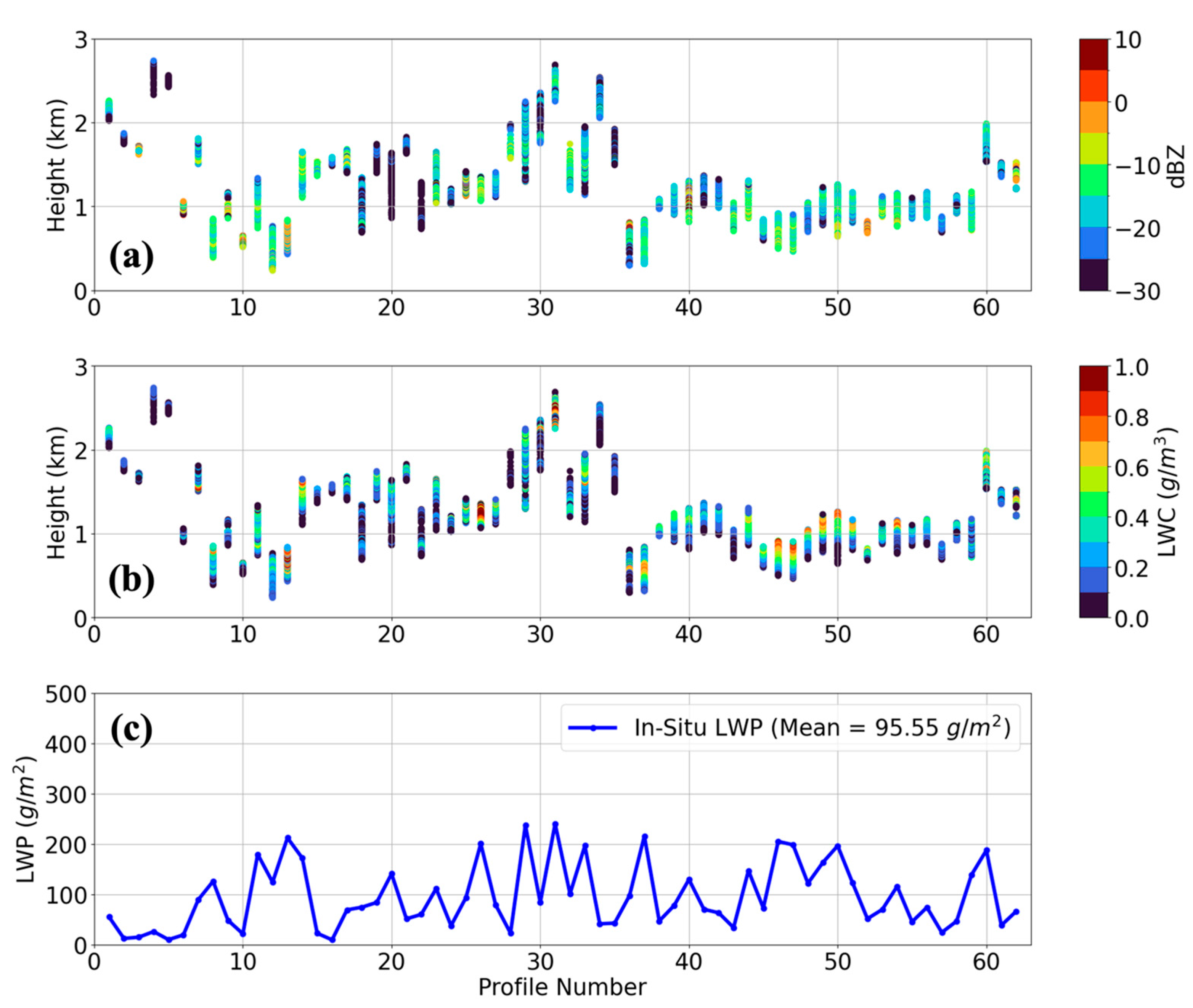

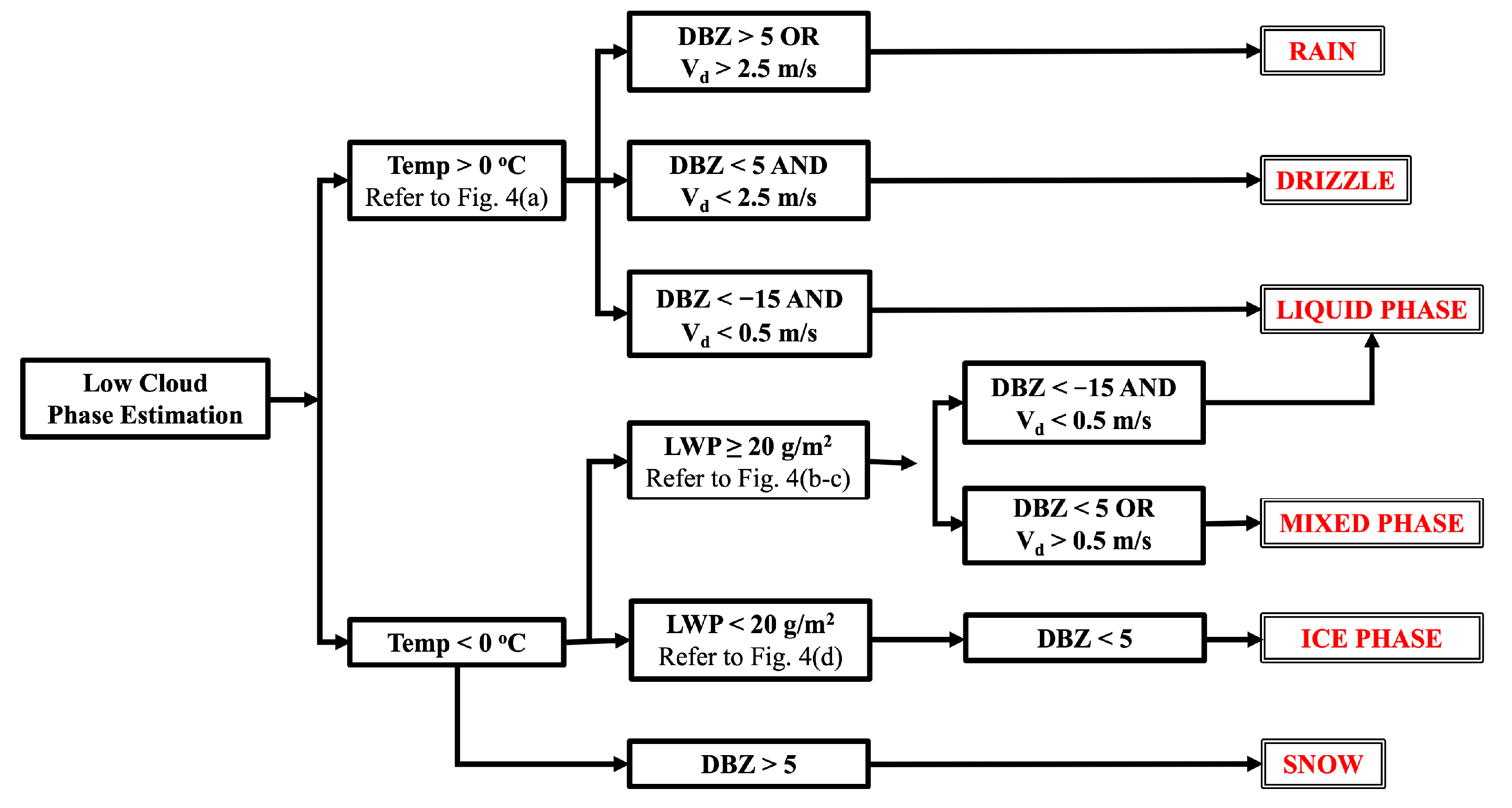
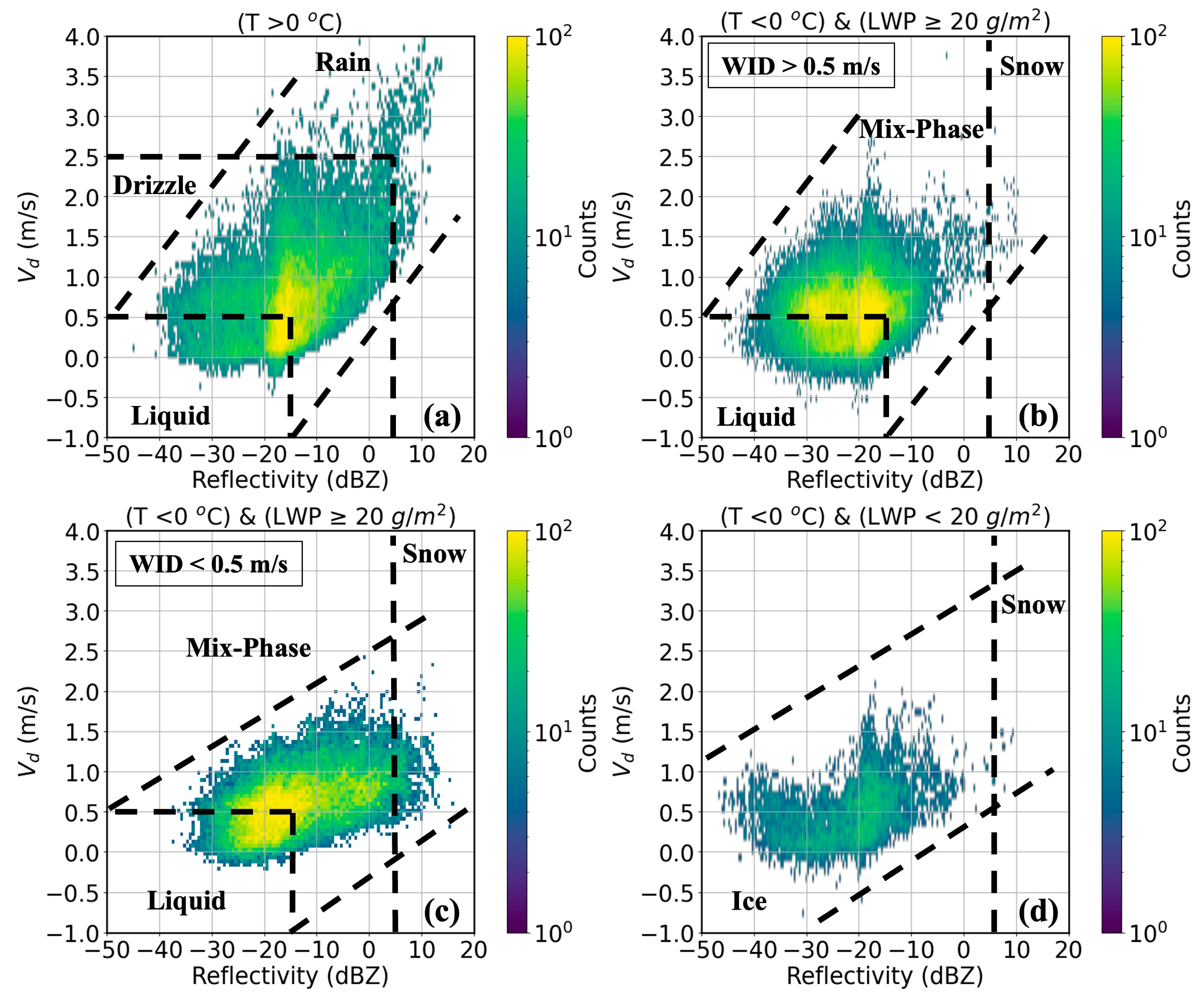
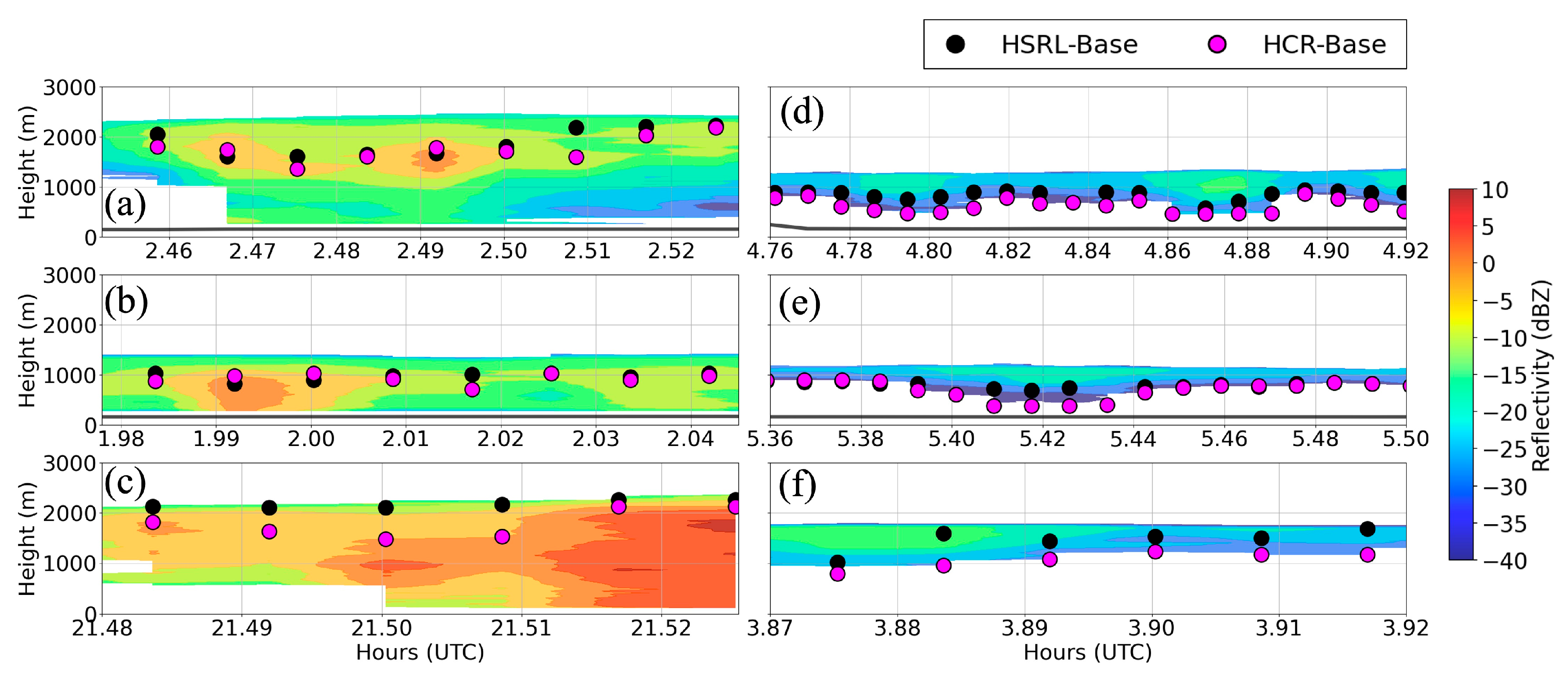

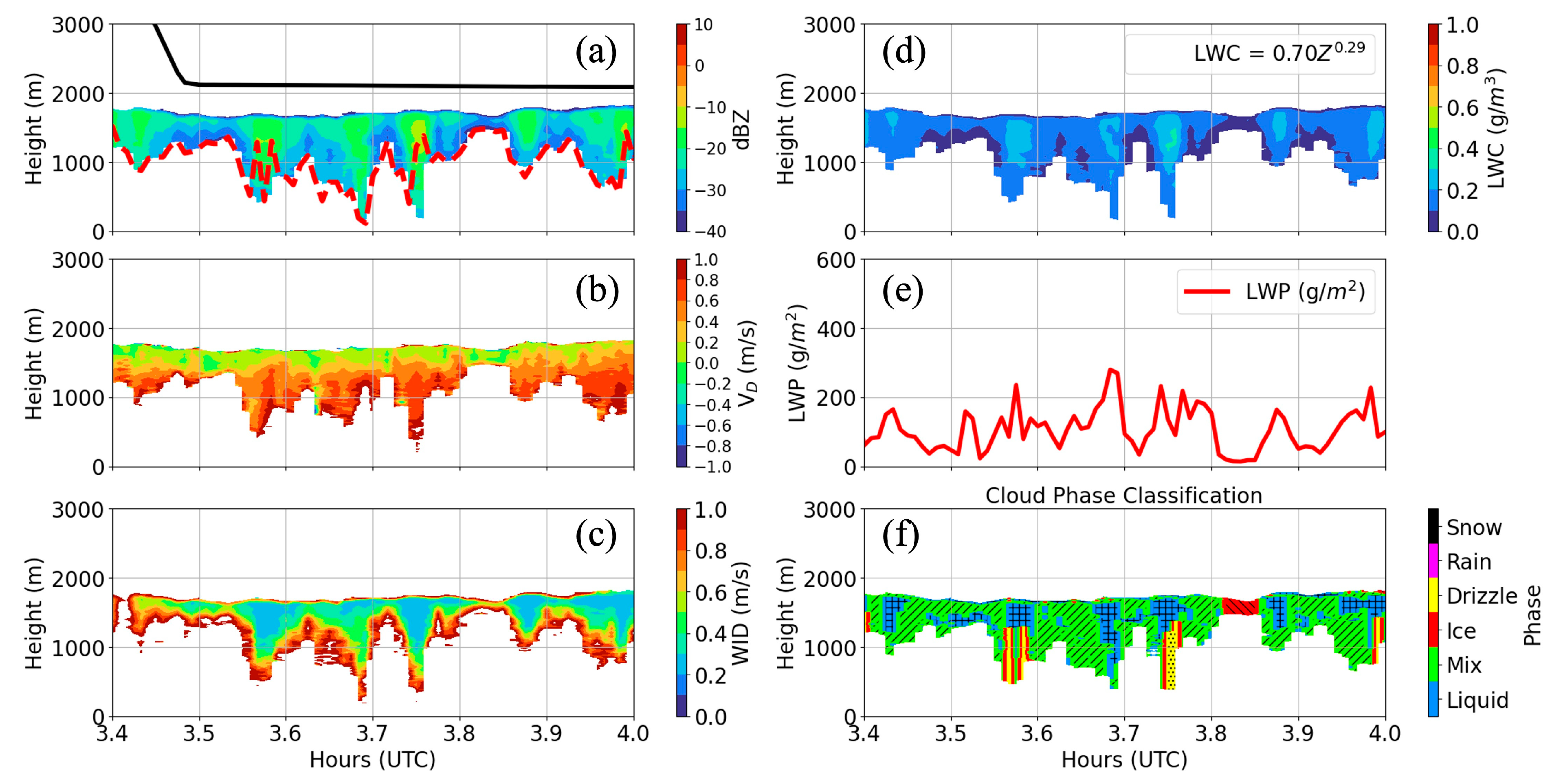

| Drizzling Cases (Looking Up) | Non-Drizzling Cases (Looking Up) | Drizzling Cases (Looking Down) | Non-Drizzling Cases (Looking Down) | |
|---|---|---|---|---|
| HCR-Htop | 1.70 ± 0.49 | 1.45 ± 0.42 | 1.82 ± 0.53 | 1.59 ± 0.55 |
| HCR-Hbase | 1.10 ± 0.51 | 0.70 ± 0.32 | 1.12 ± 0.60 | 0.64 ± 0.53 |
| HSRL-Hbase | 1.35 ± 0.43 | 0.91 ± 0.38 | 1.70 ± 0.54 | 0.97 ± 0.62 |
| In situ Hbase | 1.18 ± 0.51 | 0.60 ± 0.56 | - | - |
| In situ Htop | 1.88 ± 0.66 | 1.87 ± 0.42 | - | - |
| MARCUS-Hbase | 0.99 ± 0.37 | 0.87 ± 0.37 | - | - |
| MARCUS-Htop | 1.50 ± 0.44 | 1.24 ± 0.44 | - | - |
| (a) 1 | Combined All | Liquid | Mixed Phase | Ice | - |
| Hit Rate (%) | 60 | 59 | 71 | 48 | - |
| Matched Samples (Count) | 176 | 137 | 25 | 14 | - |
| (b) 2 | Combined All | Liquid | Frozen | Drizzle | Rain |
| Hit Rate (%) | 70 | 75 | 52 | 66 | 100 |
| Matched Samples (Count) | 45,606 | 23,901 | 4121 | 16,213 | 1371 |
| (a) | Results from SOCRATES | Results from MARCUS | ||
| HCR Phase | MLR | WACR-MWR | Thermo-Cloud Phase | |
| Liquid % | 64.0 | 52.2 | 58.6 | 56.8 |
| Mixed % | 28.8 | 9.5 | 30.7 | 27.2 |
| Ice % | 7.2 | 38.2 | 10.6 | 15.9 |
| (b) | HCR Phase | PID scheme | ||
| Liquid % | 40.6 | 56.3 | ||
| Mix % | 18.3 | - | ||
| Melting % | - | 1.9 | ||
| Frozen % | 8.8 | 11.5 | ||
| Drizzle % | 29.1 | 28.4 | ||
| Rain % | 3.2 | 1.9 | ||
Disclaimer/Publisher’s Note: The statements, opinions and data contained in all publications are solely those of the individual author(s) and contributor(s) and not of MDPI and/or the editor(s). MDPI and/or the editor(s) disclaim responsibility for any injury to people or property resulting from any ideas, methods, instructions or products referred to in the content. |
© 2025 by the authors. Licensee MDPI, Basel, Switzerland. This article is an open access article distributed under the terms and conditions of the Creative Commons Attribution (CC BY) license (https://creativecommons.org/licenses/by/4.0/).
Share and Cite
Das, A.; Xi, B.; Zheng, X.; Dong, X. Marine Boundary Layer Cloud Boundaries and Phase Estimation Using Airborne Radar and In Situ Measurements During the SOCRATES Campaign over Southern Ocean. Atmosphere 2025, 16, 1195. https://doi.org/10.3390/atmos16101195
Das A, Xi B, Zheng X, Dong X. Marine Boundary Layer Cloud Boundaries and Phase Estimation Using Airborne Radar and In Situ Measurements During the SOCRATES Campaign over Southern Ocean. Atmosphere. 2025; 16(10):1195. https://doi.org/10.3390/atmos16101195
Chicago/Turabian StyleDas, Anik, Baike Xi, Xiaojian Zheng, and Xiquan Dong. 2025. "Marine Boundary Layer Cloud Boundaries and Phase Estimation Using Airborne Radar and In Situ Measurements During the SOCRATES Campaign over Southern Ocean" Atmosphere 16, no. 10: 1195. https://doi.org/10.3390/atmos16101195
APA StyleDas, A., Xi, B., Zheng, X., & Dong, X. (2025). Marine Boundary Layer Cloud Boundaries and Phase Estimation Using Airborne Radar and In Situ Measurements During the SOCRATES Campaign over Southern Ocean. Atmosphere, 16(10), 1195. https://doi.org/10.3390/atmos16101195






